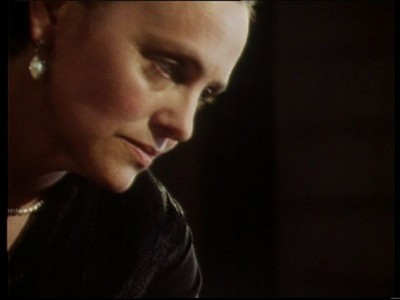A Paper Delivered at a meeting of the American Society for Eighteenth Century Studies conference
Richmond, Va, March 26-29, 2009. "The Eighteenth Century on Film -- I." Chairperson: John O'Neill. Panelists: David Richter, "Visual Allegoresis and Social Tensions in Joe Wright's Pride and Prejudice;" Ellen Moody, "'How you all must have laughed. Such a witty masquerade:' Clarissa 1991", Beatrice Fink, "Ridicule: Patrice Leconte's Satirical Take on Pre-Revolutionary France." I publish the paper on this website to make the paper widely available, complete with scholarly notes."'How you all must have laughed. Such a witty masquerade:" Clarissa 1991 1
by Ellen Moody
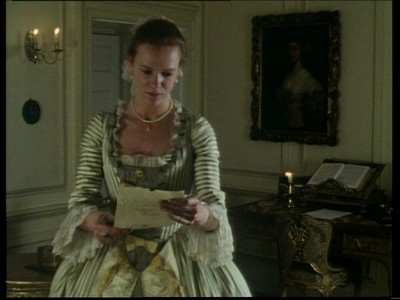
I come here today to contradict the widespread academic scuttlebutt which has it that the 1991 BBC mini-series is so bad it's embarrassing to watch (or be caught watching).2. To the contrary, like a large number of 1990s film adaptations, Clarissa 1991 skillfully merges expensively-produced multilayered filmic techniques to translate its main source effectively as well as provide a coherent contemporary perspective.3. Film critics have shown that it makes expert use of televisual and gothic art,4 and participates in the impact of 20th century feminism on US and UK TV and criticism.5. I will show the film-makers use images, motifs, and distinctive themes drawn from eighteenth century art and Richardson's Clarissa6 to create a gorgeously repellent and troubling experience.
Clarissa 1991 is not a transposition or faithful film adaptation. It's a commentary: the film-makers achieve considerable fidelity, while departing from their main textual source to convey and interpret, alter and occasionally critique it.7. They center on the destructive cruelty of Robert Lovelace who seeks through sexual seduction or assault to master the heroine, Clarissa Harlowe, and on the malicious distrust and envy of her elder brother, James Harlowe, who seeks to exploit her financially and also to subjugate her sexually, through marrying her to Roger Solmes, whom we are to find extremely distasteful, worryingly sycophantic, perhaps sexually deranged:
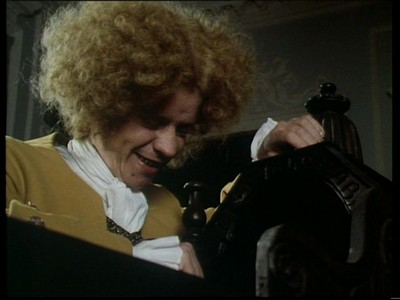
The film's sequences of images are dominated by scenes of assault, emotional and bodily, flight and sudden stillness. These replace the obsessive multiple encounters in Richardson's text of Clarissa with her family at Harlowe Place; at St Albans and Hampstead between her and Lovelace, and after the rape between her, Lovelace and the prostitutes.
We watch repeated obsessive parallel sequences of montage, with camera work focusing in on the same parts of somebody's body, most often a hand doing something. Examples: Clarissa tracked going down stairs, her hand on a balustrade; Clarissa hastening anxiously through a dark garden; on the way back assailed by her brother; assaulted by him to ferret letters from her bodice while their sister, Arabella and Arabella's maid, Betty, hold her down. Clarissa raped by Lovelace, analogously held down by the prostitutes, and left in exactly the position she was in at the end of her nightmare.
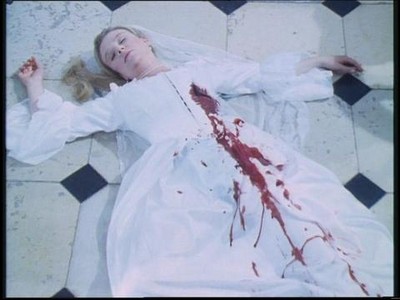
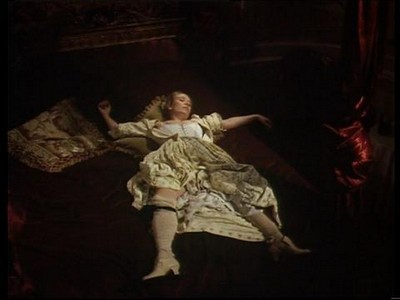
Clarissa's maid, Hannah tracked down the stairs, into the garden, her hand focused on; accosted by James while Arabella holds her, letters ripped from her bodice, ejected from Harlowe Place by strategem (Part 1, Episodes 1, 3, 4, Part 2, Episode 1; Part 4, Episode 2).
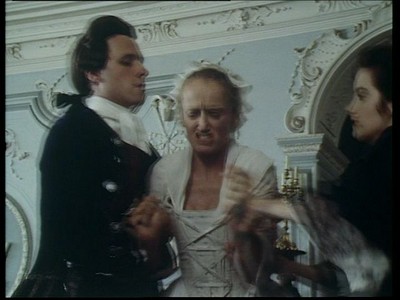
Clarissa's true friend, Anna, chased up a stairwell by Mrs Howe, her mother, slapped, her dress invaded, a letter snatched away, only she grabs it back and tears it up (Part 2, Episode 1, repeated again in Part 2, Episode 3):
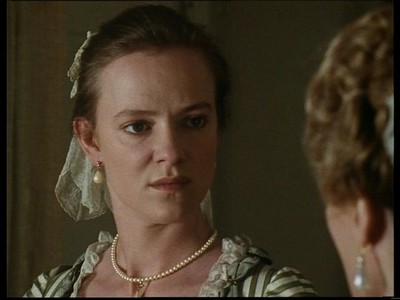
Words and startling gestures prompt satiric laughter at anyone who is sensitive or in need of support or respect. Snide insults, characters who are needle artists, snarls, bitter outcries are commonplace responses to reproach and appeal. The pleasures of Arabella derive from her sexual compliance but also her writing down shared spite dictated by her brother-lover:
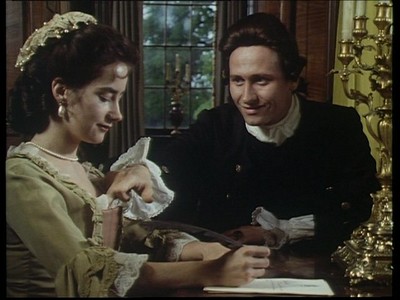
Even Lovelace is targeted: late in the film (Part 4, Episode 4), after he's read Clarissa's one strategic letter, and emerges from his room with a grave somewhat paralyzed look on his face (accompanied by Clarissa's voice-over), the brothel madam, Mrs Sinclair appears to lead him to a new virgin: we see the sumptuous dress Clarissa wore for the dinner party, and the female turns, to reveal a repulsive prostitute Deb gleefully displaying her body parts, while she jeeringly parodies Clarissa: "Oh, Mr Lovelace my soul is above you .... ".
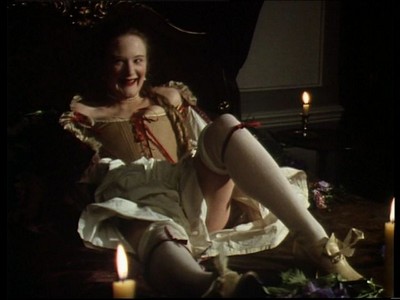
She and Mrs Sinclair laugh raucously and then Mrs Sinclair caresses her. In the book, placed amid Lovelace's unashamed memories of bullying Clarissa's landlord who shielded a panicked ill Clarissa, the prostitutes' imitations of Clary amused Lovelace.
At the same time, verbal plangent ironies and grave presences replace satiric passages in Richardson. The film's secondary heroine, Anna Howe parallels the film's Clarissa instead of (as in the book more than occasionally) Lovelace. The filmic Anna never rejects or pressures her friend to do what would violate their shared ideals. Her gravity, serious earnestness, seemingly helpless activity in two added scenes, and yearning expressions may be epitomized in the strained retort of this scene in reply to her mother's "I will not have my house made a sanctuary for young girls' who defy their parents' will: it's not "mere fancy to wish to have a mind of one's own" (Clarissa 1991, Part 2, Episode 1).9
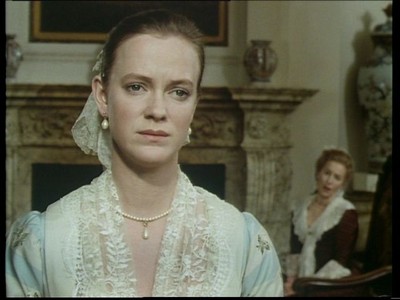
Richardson's Hampstead landlady is a partly satirized readily deluded figure, and the one younger woman in the book not attracted to Lovelace, Miss Rawlins, is stigmatized as an unattractive old maid; the filmic Mrs Moore combines these two women and distrusts Lovelace:
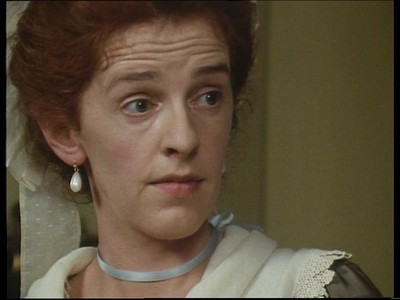
She is saying "don't worry, you'll be safe here" and looking askance at Lovelace
Numerous specific allusions to satiric and lyric works of eighteenth century art convey raillery and fearfulness visually.10 Strong dramatic irony occurs early in the novel when in Lovelace's first letter, Lovelace displays his cold egoism, goal of triumph, and strategic hypocrisy (SR, Clarissa, Letter 31, I, 142), none of which Richardson's Clarissa really grasps until near mid-point when after a faked fire, she experiences his violent petting as a prelude to coerced intercourse.11. So, early in the film we find ourselves in a spring-like beautifully green pastoral setting, a wood, and watch Lovelace take aim, fire, bring down a bird, and then slowly wring its neck as he explains his plans to his confidant, Jack Belford. The filmic Lovelace's words are taken from Richardson's book and allude to Pope's Windsor Forest where a similar bird is brought down by a hunter and the reader's pity elicited, e.g, "The sport, Jack, the sport! ... girls are not gold, Jack ... but there is nothing sweeter" than Clarissa "humbled" and on the ground.12
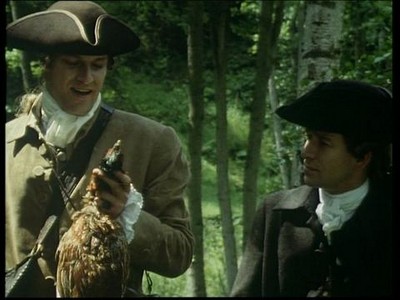
This neck gesture is repeated when Clarissa's brother tries to force her to accept Solmes.
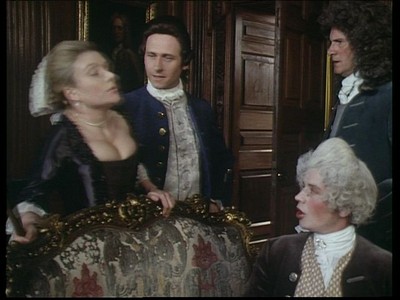
We remember this open glade, and the wrenched necks when after Lovelace has maneuvred Clarissa into appearing to be his wife in Mrs Sinclair's brothel, we find ourselves in the same glade and hear the Harlowe mole, Lovelace's spy, Joe questioning Lovelace about the documents Joe has gathered about Lovelace's previous history as a manipulative rapist. Richardson's text (SR, Clarissa, Letters 96, 139-40, I, 385, 494-97) emphasizes Joe's false piety and hypocrisy; the film, the insinuated glee in Lovelace's parodic answer to Joe's protest, "But not rape:" "On my honor. Rape is an ugly word and far less common than people imagine."
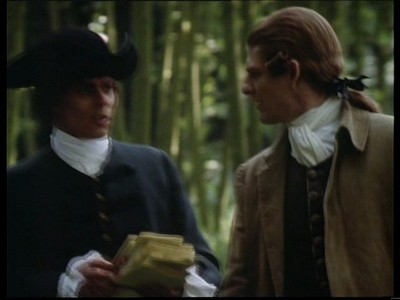
Further specific allusions include: verse from Cowley found in Richardson transposed into a newly written salacious scene at Lovelace's dinner party; imitations of contemporary and Highmore's pictures, songs from Purcell's opera Dido and Aeneas, especially "Remember me," which replaces Otway's Venice Preserved.13
Alienating and thoughtful eighteenth century general motifs laden the film too. In a late tracking sequence, Lovelace delivers a wildly amoral speech on behalf of promiscuity. Were this naturalistic drama (which it is not), we might talk of schizophrenia: when last seen Lovelace had behaved hysterically when at swordpoint Jack Belford barred his way to Clarissa. But we are in a stylized Restoration comedy [I substitute a series of stills and transcript of the dialogue in lieu of the 2 minute clip]:
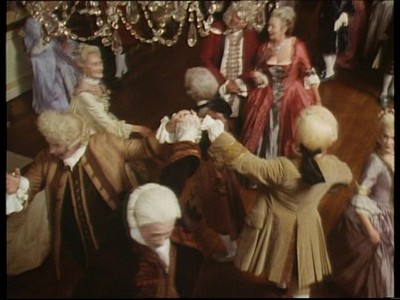
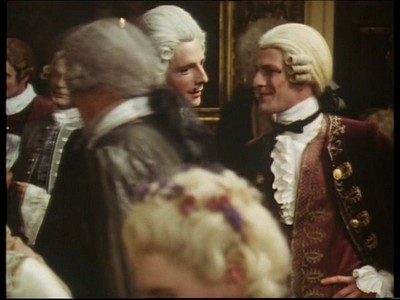
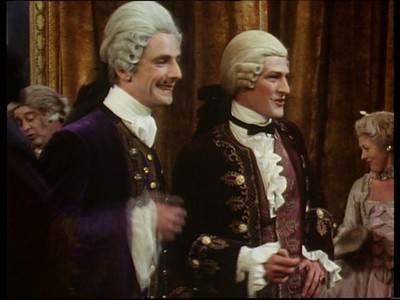
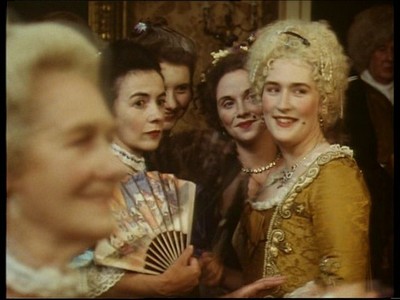
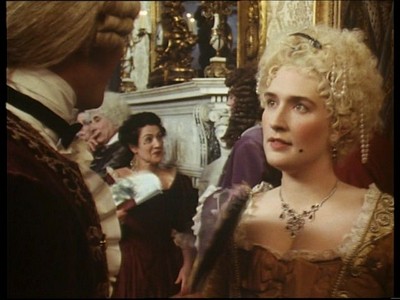
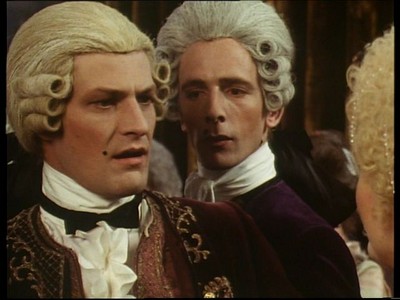
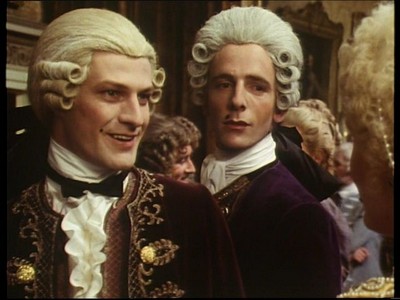
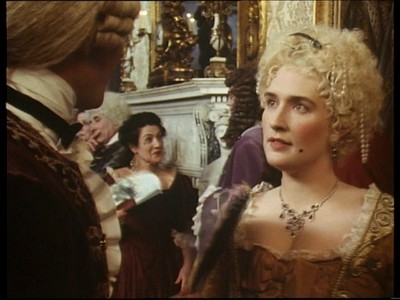
Part 4, Episode 3 ("Arrested")Establishment shot: overdressed, overmade-up people dancing 18th century minuets, lively
Mastershot of whole room, we see farther, hear laughter, and then conversation as Lovelace and male confidant emerge: Lovelace. Why should marriage be a life sentence, why should not men and women do as birds do, change partners every year. Once I'm in parliament I shall introduce a bill for annual marriage. What a splendid reform. Eradicate any number of capital sins.
Short of group of women talking, spy Lovelace, talking of him, we see blonde woman in orange-yellow dress. Lovelace alternating with the confidant list the advantages. Rape, adultery, bigamy, duelling, murder (we see his face through the crowd of dancers). No more domestic bondage. Marriage would be a perpetual honeymoon. What glorious variety, or freedom of choice, everyone would be married a dozen times at least. Churches wold be the principle markets for the fair sex. Congregatoins would swell, in short a total improvement in morals, manners, and happines of both sexes.
Blonde lady walks over to him as he walks forward and accost him. "How does Miss Harlowe, sir?"
Lovelace. "I have not seen Miss Harlowe for some days."
Lady: "If what I have heard is true, sir, you have much to answer for on her account."
Lovelace walking quickly forward to get ahead of her. "That lady has so much virtue and so much delicacy that little ins are great ones in her eyes."
Lady catches up and gets enough in front of him to bar his way slightly: "No one who knows Mr. Lovelace believes he can commit little sins."
Lovelace: "You are very good to me, Miss D'Oily."
Miss D'Oily. "Indeed sir I am not." (Opens her fan with a snap in his face, and walks off.)
Miss D'Oily is at Colonel Ambrose's ball in Richardon's Clarissa; but the matter about yearly marriages has been displaced (cf SR, Clarissa, Letter 254, 322, 325, 367, II, 872-74, 1025, 1133-37 and Clarissa 1991 Part 4, most of Episode 3 and the first sequence of images of 4), so its impact is turned directly on Lovelace, and may be seen as mockery of marriage and brutality, as misogyny or a satiric picture of people's real motives, or as an exposure of the thinness of the hero's carapace, for the scene concludes with Lovelace joining the dance, only to be confronted with an arrogant real Lady Betty who when he kneels to her reviles him, "Impersonate me with your strumpets," and slaps his face hard twice. He is then ostracized and the scene dissolves to very dark room where gradually we make out Clarissa at her desk writing a letter (Part 4, Episode 3).14.
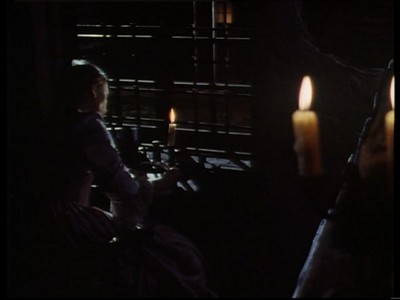
A long multiperspective tracking sequence early in the film recalls eighteenth-century pastoral landscape art and proto-feminist motifs in drama and novels. The tracking sequence is partly occasioned by a letter we watch Lovelace hide in the Howe gardens.
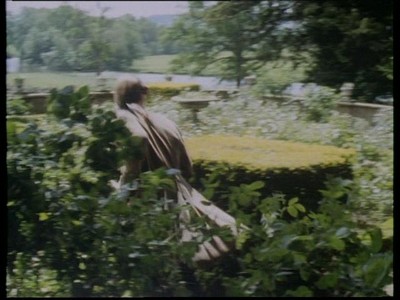
In Richardson's book Clarissa's visit to Anna is represented by a gap in the letters (SR, Clarissa, see the gap between Letters 6 & 7, I, 55-61). The filmic Clary and Anna's conversation functions like and echoes other eighteenth century scenes; for example, in James Shirley's Hyde Park, Isabelle de Charriere's Caliste, or Letters written from Lausanne and Jane Austen's Emma.15 In such scenes female characters assert they do not want to marry and explain why not.
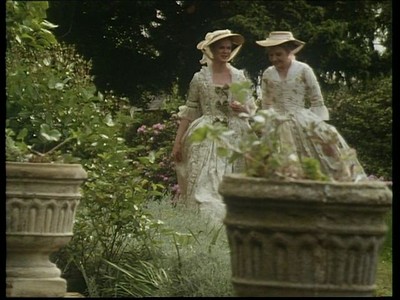
We see Anna's eager animated face as they discuss the cons of marriage. I quote the film's Clary: "Sacrifice my independence? Love, honor, and obey, can you honestly promise that?" Anna: "Promising's not the problem." Their lines, facial expressions and body language suggest Clarissa's uncertain attraction to Lovelace but also the strength of their real friendship. To Anna's, "But do you never mean to marry," Clary says: "I have everything I need, my books, my friends ... as they come upon Lovelace's letter. Clarissa flees:
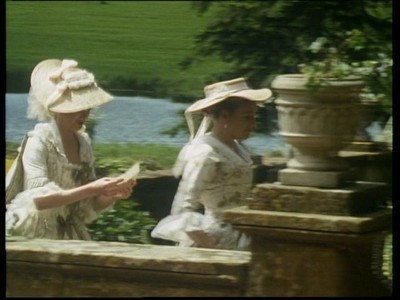
They continue talking as they come up to a temple, and spontaneously break into a run, Clarissa leading the way.
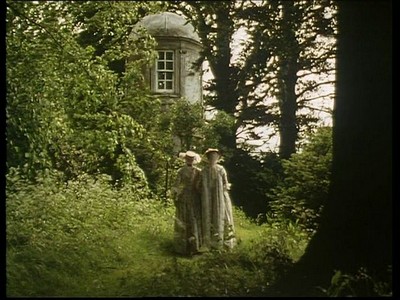
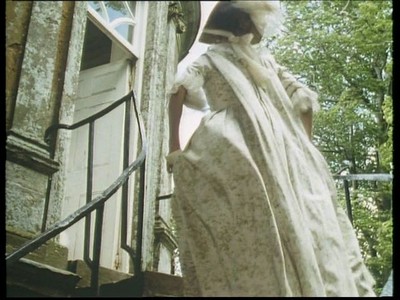
Once inside, they gently tease one another, and Clarissa explains her comment "Mr Lovelace has no heart, no true feelings," by saying "Mr Lovelace does not know how to love:"
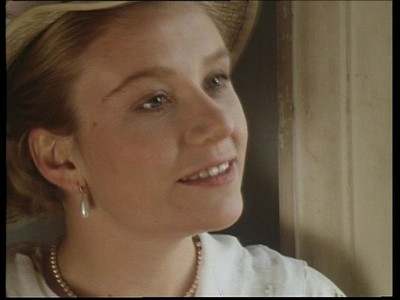
The scene sets the film's framework which emphasizes women's roles.16 The film-makers select, add and direct scenes throughout the film so as to bring out the importance of complicit and hesitant, subservient and wary women who support the aggressive material creed of almost all the characters. For example, the last genuine close-up, where the camera comes near a face in the film, focuses us for a few lingering seconds on Lorna Heilbron as Mrs Howe.
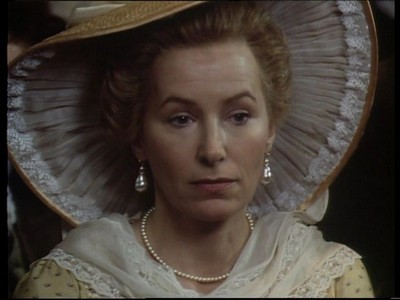
She looks inward: her decision not to take Clarissa was a central one which left Clarissa vulnerable, led to her death, and now this marriage, for, as in the book, the filmic Anna has agreed to marry Hickman in memory of what happened to Clarissa. This memory then makes the actress turn to watch her daughter in glad relief:
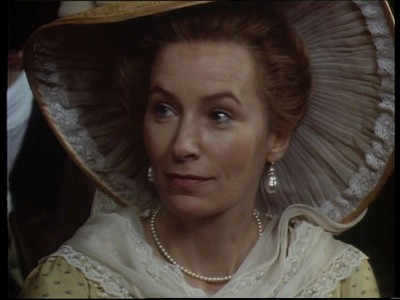
The film's epistolarity is another general mark of its eighteenth-century origins and is made technologically filmic.17 It's not just that paper as well as letters are everywhere.18 In several long sequences, voice-over is used to accompany a switching back and forth of scenes while the letter is read: a future or immediately present action occurring elsewhere is vividly present and seen from a subjective standpoint. These subjective dramatic narratives are interwoven with improbable events, like as Lovelace laughing wildly on the other side of a door in Clarissa's room's wall that only closes from the outside:
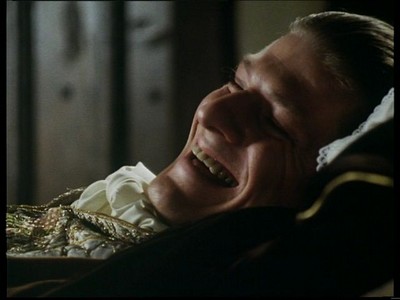
Radcliffean scenes where our terrorized heroine resorts to moving a chest over against that wall:
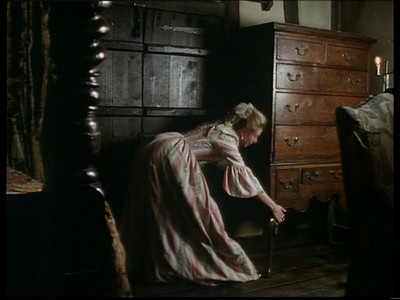
The ritual-like emerges in these epistolary sequences, e.g., the burial ceremony of Clarissa in Harlowe house:
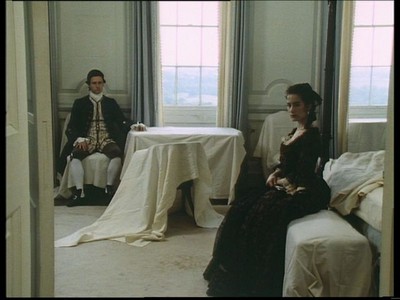
In this clip [I substitute some stills in lieu of the 15 second clip] there is an ironic distance between what Lovelace is saying and what he is doing: he says Clarissa has such power over him, he is near marrying her, while we watch his paid prostitutes set up a trap (from Letter 153, I, 520)19
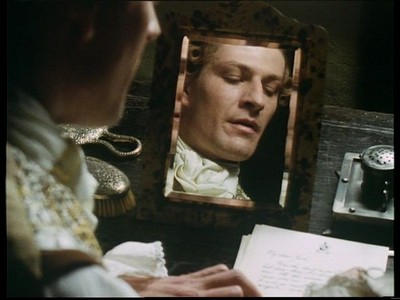
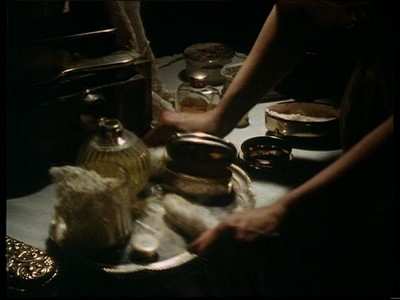
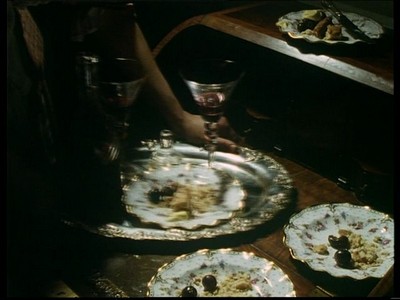
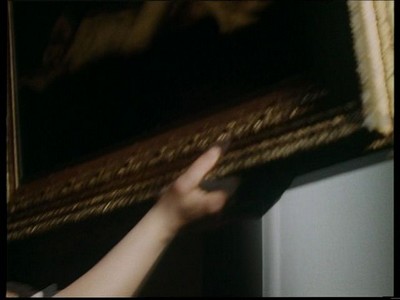
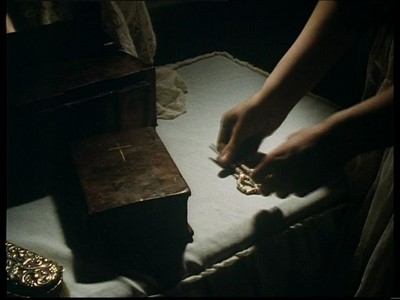
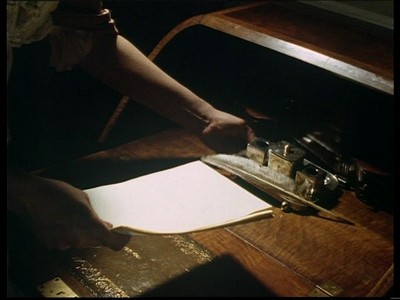
The result is like the haunting "dream-like continuity" Richardson's novel used to be praised for.20
Richardson says he primarily uses letters to expose the "inmost recesses" of his characters' minds.21 Clarissa 1991, like some diatribe warning people about the risks of social life on the Net, insists on the power of letters to produce fake identities. The performance aspect of filmic epistolarity enables its most powerful motif: masquerade. After the rape, the filmic Clarissa strips further, washes her body obsessively
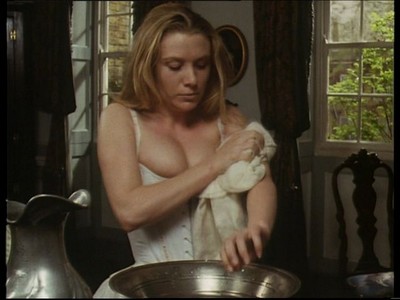
dresses plainly, flattens and ties her hair down before a mirror
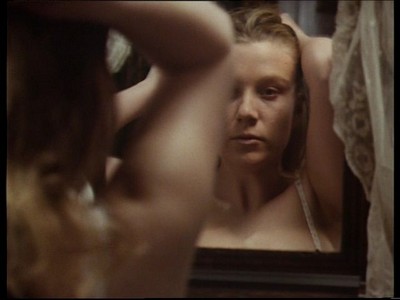
and then between the prostitutes, Sally and Deborah, is brought before Lovelace and asks him bluntly: "What further evils are reserved for me" as she finds she is his "prisoner." He puts out his hand and says "Madam. Clarissa. I am truly truly sorry." She backs away, and says "Don't touch me" with a revulsed expression on her face:
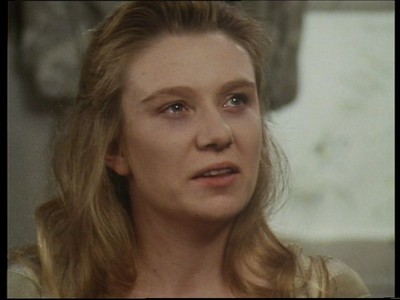
While the camera is on her face, we hear Lovelace say "I love you," and she replies: "Some new strategem." Lovelace: "Believe me". Clarissa: "Again? As I believed Captain Tomlinson? and Lady Betty? How you all must have laughed. Such a witty masquerade."
The film's use of flamboyant masquerade to deceive and to hurt gives it its keen edge and power. Diana Quick as the fake cool ever so plausible exquisitely poised Lady Betty exhibits an impeccable feel for presenting the seriously awry. In this clip we see her when, having succeeded in bringing Clarissa back to Mrs Sinclair's in a thoroughly drugged state, she slips out into the hall, takes off her hat and reveals a face which delights in cruel deceit [I again offer a series of stills in lieu of the 30 second clip]:
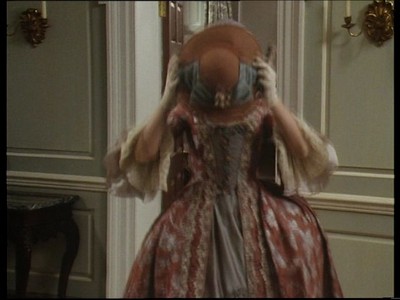
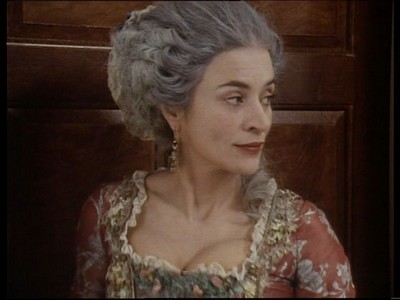
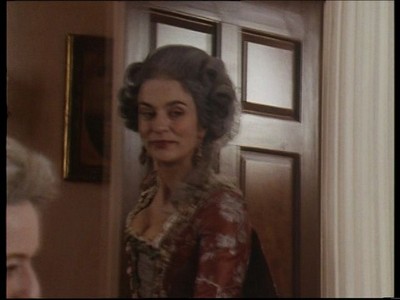
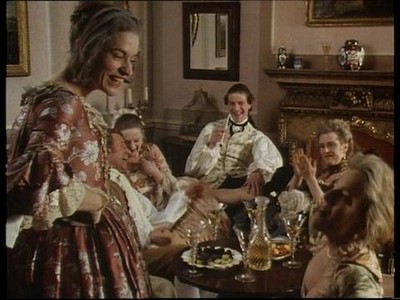
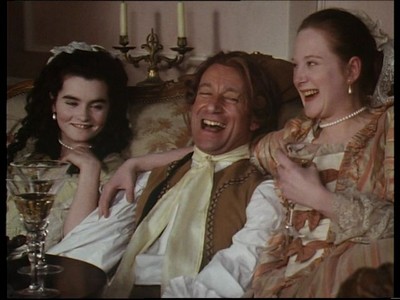
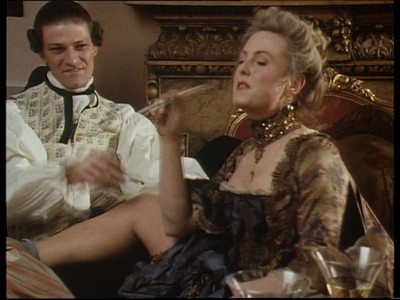
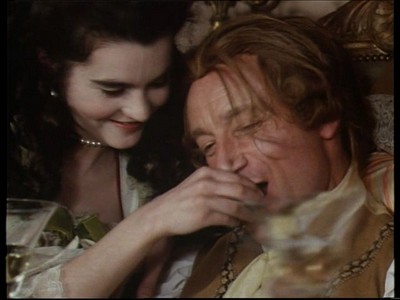
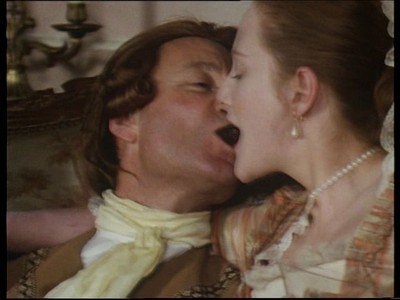
When she throws off the wig to reveal spare ugly grey hair, she is unnerving, the profferred congratulations electrifying. The moment is more than fleeting wanton self-erasure, for the masquerade began early in the film, with Lovelace's donning his disguise as a peasant:
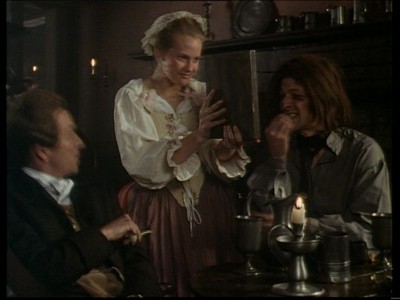
The over-cosmeticized Solmes is ghastly; he conveys sickness by every twitch of his trembling body. His wig like Lovelace's is filthy; his teeth really diseased (like that of the fake Lady Charlotte). Rankness is felt throughout and is highlighted in startling turnabouts, such as when a nauseating quality is physically felt when Lovelace spits out his foul teeth to show Mrs Moore he is not an old man and harmless (Part 4, Episode 5).
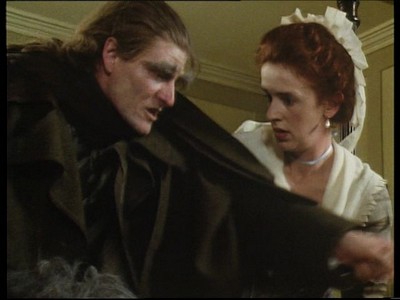
In an earlier parallel scene when Michael Feast as Captain Tomlinson threw off his wig to reveal a jeering face and baldness, they all laughed too.
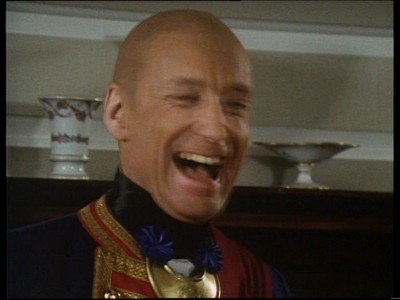
In Masquerade and Civilization, Terry Castle says when "eighteenth century satirists wishes to depict a larger cultural sickness -- the morbid state of civilization itself -- ," they turned to masquerade to show "the world's abounding hypocrisy and deceit," its chicanery, travesties, utter bad faith.22 The pleasure of masquerade is here too. This is a costume drama whose excess is intendedly oppressive, life-threatening. In this film, the safety Clarissa seeks is nowhere to be found but we are to infer it's potentially available in somber truthful behavior such as we see at Anna's wedding.23
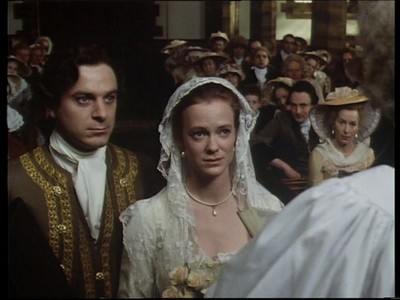
This film vindicates Clarissa's adhered to determination to make her future life for herself include consideration for her private space, needs and values; and it conveys a grief-striken or tragic joy when she is blithe to go into oblivion because there is no decent choice on offer. Early on in the book she says "I don't know what to wish, without a sin! -- Yet I wish it would please God to take me to his mercy! -- I can meet with none here! -- What a world is this! What is there in it desirable? The good we hope for, so strangely mixed, that one knows not what to wish for: and one half of mankind tormenting the other, and being tormented themselves in tormenting" (SR, Clarissa, Letters 8, 52, I, 62 & 224) As the filmic Clarissa lies dying, she tells Belford:
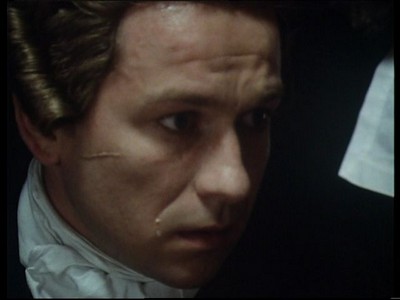
"Death's not a punishment. Death is my friend. The only real dishonor is compromise, and self-betrayal. Death is my independence" (Clarissa 1991, Part 4, Episodes 4 & 5)24
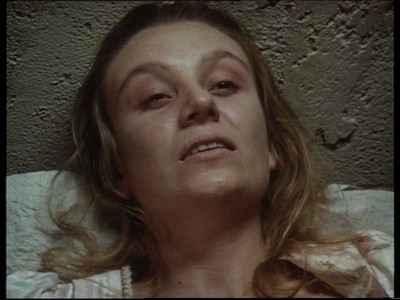
The film's final spoken words given to Nokes and Barron's Uncle Anthony Harlowe in its (anti-Thatcherite) final scene are: "Money will never pay for what we've done. This family is broken. Greed has destroyed its own heart." His act, severing himself from the family,
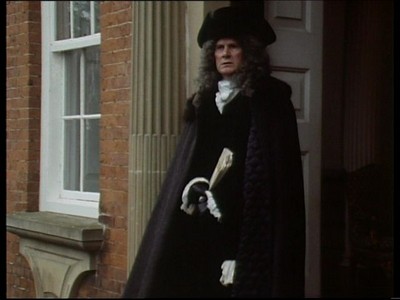
is a fitting translation of other of Richardson's Clarissa's words heard early in the book: "the world is but one great family; originally it was so; what then is this narrow selfishness in us, but relationship remembered against relationship forgot." This film is, in my view, an alternatingly ribald, splendid and quietly thoughtful theatrical translation of Richardson's book.
It is not without flaws and failures. It is too short.25 In the four part version, we are 2/5s through the fourth part when the rape occurs; that leaves 3/5s of a quarter of the film for a third of the source text. Important omissions include Lovelace's second attempt to rape Clarissa, her attempts to win some of the prostitutes to her side, her escape, two moves, to a sponging house and then to modest lodgings in London; the prostitutes' harassing visits to the first; Lovelace's stalking in the second, her bitter searching of her heart in her meditations, the intransigence of her family.
Not enough time was devoted to the film-makers' alteration of Richardson's depiction of Belford and Lovelace's generally supportive relationship to one emphatic with unacknowledged intense rivalry: Nokes and Barron add repeated grating denigrations of Belford by Lovelace, and in 4 scenes turn them into highly competitive duellists, but more scenes of Belford, active apart from Lovelace, on behalf of Clarissa, with her, and at least one of him writing were needed. As it is, many viewers seem to miss the point of the final duel which concludes in Belford's enraged killing of Lovelace as a mirror image of himself he can no longer stand to look at
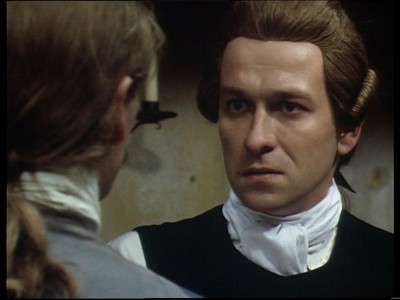
As Lovelace Sean Bean projects a tortured pride as a mask to hold back an irretrievable wretchedness,
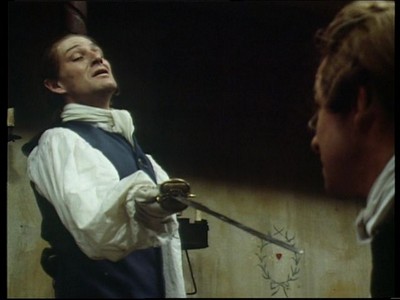
and then seeing the filmic Belford's determination to murder him, allows Belford to get close to him. Belford can then fit his body against Lovelace's and thrust his sword upwards into Lovelace's body. By contrast, Richardson's Lovelace looks to "win" and behaves "outrageously" when he sees he will die.
[I provide a transcript of this misunderstood scene]Establishment shot: Lovelace boasting and swearing revenge, moving about quickly, a grim Belford seen; then Belford speaks and Lovelace begins to menace him with sword, Belford fends him off, and then Lovelace grins angrily, comes forward and Belford says the truth:Lovelace with sword hanging by him: "I'll have my revenge on them ... I shall sweep away every last vestige of the Harlowe tribe from the face of the earth."
Belford there, facing him, rigid.
Lovelace says something which ends with "my Clarissa Lovelace."
Belford: "Stop thinking of yourself. You betrayed her."
Lovelace: "Take care, Jack, I love you like a brother but I warn you do not provoke me."
Belford: "You violated her. You killed her."
Lovelace shouts. "No. Don't play the moralist with me. A rake's a rake, Jack. We're two of a kind you and I."
Jack's face seen in camera, and then a little further off so we see him pushing Lovelace's sword away from him. Lovelace (sneering, harsh voice): "Always hunted as a pair. I only seem more wicked because I am handsome and you are ugly."
Jack's face. Lovelace: "So poor frightened puss always throws herself into my paws and not into yours."
Jack: "Have you learned nothing?"
Lovelace: "What is there to learn? Is death a natural consequence of rape? (screech in voice). You are not so innocent, my friend. You knew my plans, every detail, every strategem, every disguise and what did you do? you did not try to save us. You're as guilty as I am, more, at least I don't pretend to piety."
Jack says something which ends in "this is not pretense", in a fury of hatred and anger and turns to fight.
Phase 2: Lovelace hits Jack hard in the arm, and he bleeds through white linen, and face and mouth bleeding after two more set-tos.
Lovelace: "Jack."
But Jack means to kill or be killed and screams: "Lovelace!"
Jack kicks Lovelace hard and begins to hit him unscrupulously every and any way he can.
Lovelace has advantage but his face uncertain, not angry, they turn, hit, turn, hit, fall, and stay for a second or so and then both slowly get up and as Lovelace holds out sword with expression of proud grief on his face (Sebastian look from Brideshead Revisited), Lovelace lets Jack push his (Jack's) body against him with his own (Lovelace's) sword to the side, and then Jack can push his sword deep into Lovelace's body.
Lovelace: "Well done, Jack, you have avenged her well. One man cannot have every woman worth having."
Jack pulls sword out as Lovelace stands there: <"May God have mercy on your soul."
Jack moves off, and stands to the side.
Lovelace before falling says: "Clarissa let this redeem my sins."
Lovelace sprawled there, Jack standing near, Jack throws his sword over Lovelace's to make a cross and walks away and we see body sprawled 26
The BBC codes of decorum limited how the rape could be shown and the way two crucial characters, Lovelace and Clarissa, were directed to keep to conventional notions of decorum and social pride or self-stability. The filmic heroine's nervousness is implied from afar: Saskia Wickham is never seen shattered or at a total loss; she is not shown a suppliant; this kind of thing is implied or kept offstage for the filmic hero too: Bean never loses his sanity and dignity in front of us (Papers I-X, 890-94; Letters 496, 511, II, 890-94, 1382-83, 1427-30). The rape scene did not begin to show us what is crucial for our understanding of all that has gone before and is to come: cruel rape. No one was unclothed; certainly Bean performed seething hatred as he looked down at the woman on the bed:
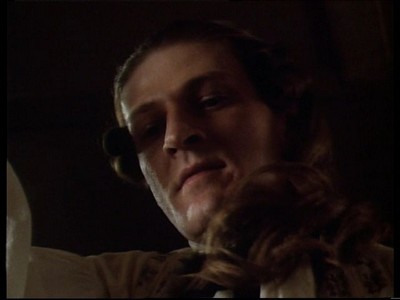
but there is nothing penetrative, and Wickham is photographed at a distance, with stylized gestures and the camera creating a gauzed-over suggestiveness
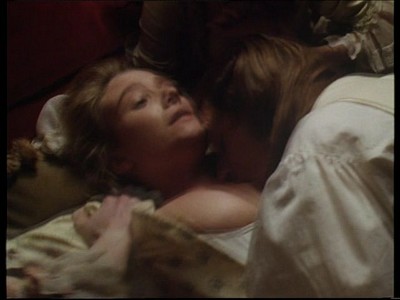
There is nothing dared of the searing humiliations suggested by Richardson's text: "But no mercy found I -- My strength, my intellects failed me! -- and then such scenes followed -- oh my dear, such dreadful scenes! -- fits upon fits (faintly indeed and imperfectly remembered) procuring me no compassion -- but death was withheld from me" (II, Letters 258, 314, II, 883, 1011).
Such genuine breaking of taboos, such as we find in Jacques Rivette's film adaptation of Diderot's La Religieuse might have led to viewers calling the BBC to complain or demand that Clarissa be saved.27 Today's television is no longer so reticent and decorous; for example, the recent ITV 2007 Persuasion presents an Anne Elliot driven into embarassingly open abjection and crying need of the hero; they risk ridicule to show us a counterpart emotionally overwrought anxious Wentworth. I would welcome a 21st century film adaptation of Clarissa that builds on this one, is much longer, takes more risks, but, like this one, does not swerve from its primary source's attack direct on some of our cherished illusions.28
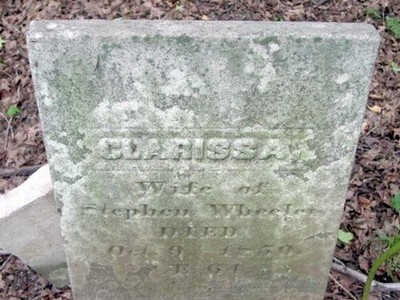
Notes
1 I will refer to this mini-series as Clarissa 1991. Clarissa 1991 was a BBC/WBGH production, screenplay by David Nokes and Janet Barron; directed by Robert Bierman, producer Kevin Loader and executive producer, Michael Wearing. Information online elsewhere (and in a private email letter to me from David Nokes) confirms that the writing of the script took a year, with each of the originally 4 conceived parts taking 3-4 months. For the cast and company details, costuming, production design, music, which as far as I can check are accurate, go to: http://www.us.imdb.com/title/tt0101066/.
2 On academic listservs and at sessions on Richardson's novels at eigheenth-century conferences I have repeatedly heard this film casually ridiculed by well-known respected Richardsonians. The older way of dismissing it was to subject it to an impossibly literalist analysis based on the unlikeness of its filmic elements to what the particular reviewer can describe literally there in Richardson's Clarissa and his or her interpretation of Richardson's novel, e.g., Lois A. Chaber, "A 'Fatal Attraction'?: The BBC and Clarissa," Eighteenth Century Fiction, 4:3 (1992):257-63. More recently the continual low esteem in which movies meant to reach a wide audience and in particular mini-series associated with women continue to be held has led to the reverse snobbery of dismissing this film for being a "ploddingly faithful" rendition of the book. This was stated by a panelist in a recent ASECS Richardsonian session. A little later and quietly a couple of people who knew that I had posted about the film favorably on C18-l came over to tell me in private they liked the film. The recent attitude which leads to a preference for analogous or free over tranposition (faithful) and commentary types is engagingly demonstrated in John Wiltshire's Recreating Jane Austen (Cambridge UP, 2001).
3 The 1990s has been called the decade of costume drama. In the cinema, on TV, the stage, extraordinary films proliferated. See Robert Giddings, The Classic Serial on Television and Radio (London: Palgrave, 2001):80-103. Nonetheless, and despite radical changes in which the way British TV industry is organized, and costume dramas and film adaptations produced, Reith's criteria that BBC television had to "inform, instruct, and entertain" is still maintained in the way most costume dramas of older high status novels are done to achieve surface historical accuracy, not to offend the sensibilities of the audience or sexual norms in the given era, and repeated claim made good that they entertain in an enlightening way. See Stuart Hood and Thalia Tabia Peterson for a concise history of the older and most recent ways British TV is produced, On Television (London: Pluto Press, 1980); Reith's statement is on p. 31; the assumptions of enlightenment and improvement may be seen passim in Andrew Davies's work whatever the individual effect of his attempts to lighten up a work through caricature and comedy and striking but carefully controlled or distantly modelled or merely suggestive sex scenes; see Sarah Cardwell, Andrew Davies (Manchester: Manchester UP, 2005), .g. 34-35, 45, and passim the individual studies of film adaptations which also show a strong feminism: the women in the series are independent characters and their sexual status vis-a-vis men is not a central measuring instrument of their worth, especially strikingly in Davies's Rebecca in his Vanity Fair.
4 See Cynthia Wall, "The Spaces of Clarissa in text and film," Eighteenth-Century Fiction on Screen, ed. Robert Mayer (Cambridge UP, 2002):108-22; Clarissa 1991 is critiqued as a gothic film in Lisa Hopkins, Screening the Gothic (Austin: Texas UP, 2005):26-36. She omits the mini-series harsh anamnesic minor-key loud music (which makes heavy use of a harpischord for percussion). In this paper I have been strongly influenced by Claire Monk, "The British Heritage Film and Its Critics," Critical Survey, 7:2 (1995):116-24; Pam Cook, Fashioning the Nation: Costume and Identity in British Cinema (London: BFI, 1996); Pam Cook and Philip Dood, edd. Women and Film: A Sight and Sound Reader (Philadelphia: Temple UP, 1993); Robert C. Allen, "A Reader-Oriented Poetics of Soap Opera," Imitations of Life, ed. Marcia A. Landy (Detroit: Wayne UP, 1990):496-524; and Christine Gledhil, ed. Home is Where the Heart Is (London: BFI, 1987), especially Tania Modleski's "Time and Desire in the Woman's Film," 326-39; and Heidi Kaye, "Gothic Film," A Companion to the Gothic, ed. David Punter (London: Blackwell, 2000):180-92.
Giddings and Selby argue that after a falling off of costume dramas in the later 1980s, Clarissa 1991 was the first, a landmark and influential film in a decade-long line of ambitious luxurious film adaptations featuring strong female leads and an increase in women directors, producers an screenplay writers, for example, The Buccaneers, The Life and Loves of a She-Devil, Moll Flanders, and the excellent Austen films of the 90s; Giddings and Selby, The Classic Serial on Television and Radio, pp. 84-88, 117-23. Giddings argues that many of the triumphs of the 90s, and especially the important sociological event of the 1995 BBC/WBGH Pride and Prejudice, were the result of a new audience and film-makers of "socially, sexually, and politically enfranchised women." Studies of the earlier industry repeatedly show that very few women were writers, producers or directors before the 1990s, Fay Weldon being one well-known exception, e.g., Robin Wade, Where the Difference Began: Some Developments in scripts and script sections in BBC Television, 1936-74 (London: BFI, 1975).
5 In an email letter to me dated January 26, 2009, David Nokes wrote " I very much enjoyed and internalized much of Mark Kinkead-Weekes's thinking in SR Dramatic Novelist" Together with Kinkead-Weekes's book (Ithaca; Cornell, 1973), Margaret Anne Doody, A Natural Passion: A Study of the Novels of Samuel Richardson (Oxford: Clarendon Press, 1974) and Terry Eagleton, The Rape of Clarissa (Minneapolis: Minnesota UP, 1982) were the key recuperative books of the era in their rejection of the old school of Freudian-Dorothy Van Ghent point of view. Other examples of books sympathetic to and defending Clarissa on her own terms include Terry Castle, Clarissa's Cyphers: Meaning and Disruption in Richardson's Clarissa; Carol Houlihan Flynn, Samuel Richardson: A Man of Letters (Princeton UP, 1982), Cynthia Wolff, Samuel Richardson and the Eighteenth-Century Puritan Character (Hamden, Conn: Archon Books, 1972). See also Katherine Rogers, "Sensitive Feminism vs Conventional Sympathy: Richardson and Fielding," A Forum on Fiction, 9:3 (1976):256-70; Janet Todd, Women's Friendship in Literature (NY: Columbia UP, 1980):9-68. Although not claimed by Nokes as influential, the outlook of this essay is the one found in Nokes and Barron's film adaptation, especially the valuing of women's friendship, as seen in Nokes and Barron's choice of focusing on Anna and Clary's talk about their desire for a single life and reluctance to marry early in the mini-series. The use of Belford to kill Lovelace does obscure the modern interpretation that Lovelace was killed by the chance reality in the fiction that Clarissa's kinsman was an excellent swordsman, not because Lovelace had done Clarissa's an egregious wrong. A similar feminist point of view can be seen in their film adaptation of Anne Bronte's The Tenant of Wildfell Hall (1996 BBC); see Sarah Cardwell, Adaptation Revisited: Televison and the classic novel (Manchester: Manchester UP, 2002):184-204 for a reading the film as refreshing iconcoclastic and feminist.
6 My text is the Folio Society 1991 reprint of the 1985 Penguin text based on Richardson's first edition prepared and introduced by Angus Ross; Samuel Richardson, Clarissa; Or, the History of a Young Lady (Bath: Bath Press, 1991), 2 volumes, with an extra introduction by Angus Wilson, modern illustrations by Simon Brett and a useful table of all the letters in this edition and those in the 1st (C1 produced by Richardson) and 3rd (Shakespeare Head and Everyman editions). I quote Richardson's text in my own and refer to it as SR, Clarissa.
7 I use Geoffrey Wagner's familiar terminology from The Novel and the Cinema (Rutherford: Fairleigh Dickinson UP, 1975):222-29. For example, in a set of films adaptations with some similar themes based on an 18th century epistolary novel, Roger Vadim's Les Liaisons Dangereuses 1960 is a free or analogous adaptation of Choderos de LaClos's later 18th century epistolary novel Les Liaisons Dangereuses; Stephen Frears' and Christopher Hampton's 1988 Les Liaisons Dangereuses a faithful or transposition film, and Miles Forman's 1989 Valmont a commentary. In imitation of Vadim, I abbreviate references to this film as Clarissa 1991. The commentary type film is the most misunderstood of the three.
8 Further variants include: Lovelace congratulating himself upon not harassing a grateful Rosebud who holds up a mirror to help him put on his disguise (Part 2, Episode 1); in a voice-over at St Albans regretting not diving at the exaggeratedly large bosom of an actress who wears a push-up bra (Part 2, Episode 3); Patty, the maid at Hampstead deceived by Lovelace's obedient servant, Will, as Will holds her down apparently in a gesture of affection, to steal Clarissa's letter to Anna (Part 3, Episode 4). I have not time to discuss the substitution of the nickname Clary for Clarissa at Harlowe Place, a common technique in these film adaptations to use central characters' nicknames, probably to make the characters feel more contemporary for viewers.
9 Richardson's paralleling of Anna and Lovelace has been pointed out many times; those who discuss this include Kinkead-Weekes, pp. 205-6; and Morris Golden, Richardson's Characters (Ann Arbor: Michigan UP, 1963):50-55.
10 As an eighteenth-century scholar David Nokes, one of the two screenplay writers, for such a novel, would naturally use verbally witty satiric comedy, allusions to eighteenth-century poetry, and dramatic scenes reminiscent of eighteenth-century plays; the feminist turn given to many of these may have been also contributed by the second writer, Janet Barron, who together with Barron (see note 5 above) also wrote the screenplay for the 1990s film The Tenant of Wildfell Hall. Now deceased; Barron was Nokes's partner in life.
Nokes's many books and articles include a much-respected scholarly biography of John Gay, Jonathan Swift, and Jane Austen (somewhat controversial because of the positions Nokes took on her life and books and unorthodox notes); I think Richardson's book has more humor and satire in it than is often acknowledged, and the film has numbers of scenes which are harsh or hard comedy; they provoke from me a kind of Hobbesian laughter. See Nokes's book where he argues that satire permeates most 18th century art, Raillery and Rage: A Study of Eighteenth Century Satire (New York: St Martin's Press, 1987):1-30.
11 In film and book Lovelace earlier plays upon her nervous susceptibility to pressure her out of her father's house and seems to set fire to the house to unnerve her (SR, Clarissa, Letters 225, 230, June 8, I, 722-28, 754-57).
12 Cf Pope's "Windsor Forest," lines 111-119, Alexander Pope: Poems: A Critical Edition, ed. Pat Rogers (Oxford: Oxford UP, 1993):53:
See! from the brake the whirring pheasant springs,
And mounts exulting on triumphant wings:
Short is his joy; he feels the fiery wound,
Flutters in blood, and panting beats the ground.
Ah! what avail his glossy, varying dyes ... "
From the screenplay: Lovelace talks of the "fowler" who set up his "prey, spreads his snares, set up his talking horse ... plants his decoys ... The sport, Jack, the sport ... A pox on their money, girls are not gold, Jack ... There is nothing sweeter than" Clarissa humbled and on the ground. (from Clarissa 1991, Part 1, Episode 2).
13 Cowley's lines are recited by Clarissa in response to Belford's invitation; in both the book and film Belford gives Clarissa a chance to change the tone of the gathering from sexy aggression to courteous intellectual talk (Part III, Episode 2). The equivalent passages occur in SR, Clarissa, Letter 161, zI, 542-44 (Clarissa writes a series of Theophrastan satirical portraits of Lovelace's friends); we are first told of her use of Cowley in Letter 222, I, 711-12 by Belford. The imitations of contemporary illustrations are of Clarissa fleeing in the garden and being pushed out the door; also Highmore's painting of the Harlowe family is vividly brought to life a number of times in set scenes where all the Harlowes face Clarissa as she comes in the door, and then we look at them all with her embedded in the middle. The songs from Purcell's Dido and Aeneas, especially "Remember me," echo the operatic music heard throughout the film, as well as occasional muted haunted operatic refrains. The book does not dramatize Lovelace's taking Clarissa to the theatre; it is rather mentioned and alluded to twice, so the focus is on Otway's words; see Letters 194, 200, I, 681, 640.
14 The letters cited show Lovelace comfortable at Ambrose's ball throughout; it is Anna who becomes distressed. This has the effect in a film of criticizing Lovelace; in Richardson's book the inference is ironic: Lovelace is still accepted even after raping a woman, while Anna's reputation is at risk and her feelings exacerbated. Another sequence which picks up on typical eighteenth century art is that of the exemplary death. The film-makers do not quail before this nor the ritual bringing back of the coffin into Harlowe Place. Clarissa dies in a Greuze-emblematic scene surrounded by a kindly nurse, physician, clergyman. They do make some changes: we have just Belford in lieu of both Belford and the cousin who arrives very late in the novel, Morden (and murders Lovelace in a duel that evokes honor killing as an acceptable behavior because we are partly to be glad Morden has done this) and Belford is presented physically close to Clarissa. In the film he takes her hand and holds it to him on the bed (rather than as in the book she stretches our her hands to both men to take). Cf Letter 467, II, 1342-45 and
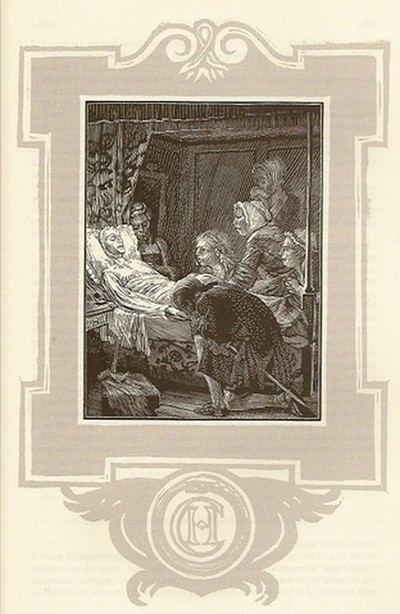
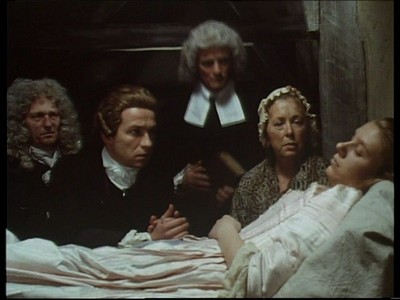
The return to Harlowe Place is controlled, ritualized:
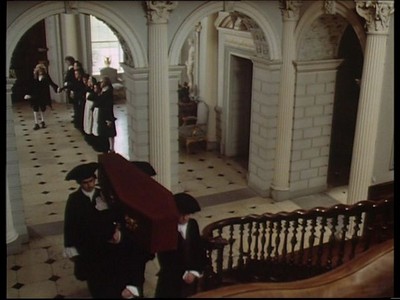
On the respect accorded non-naturalism in TV film criticism, see John Caughie, Televison Drama: Realism, Modernism and British Culture (Oxford: Oxford UP, 2000):152-78.
15 Cf James Shirley's comic Hyde Park, Act I, Scene ii from James Shirley, Plays, ed. Edmund Gosse, (London: Unwin, 1902), Mermaid series, pp. 188ff. where the Widow, Mistress Bonavent whose husband has been missing, lost at sea for 7 years, the requisite number of years for her to remarry, she now has a lover she wants to marry. Her friend & missing husband's cousin, Mistress Carol, makes fun of her and says her conduct makes women looked at askance:
Mis. Car. "No marvel if men rail upon you then,
And doubt whether a widow may be saved,
We maids are thought the worse on, for your easiness.
How are poor women overseen! We must
Cast away ourselves upon a whining lover,
In charity; I hope my cousin's ghost
Will meet you as you go to church, or if
You' scape it them, upon the wedding night."
Mis. Bon. "Fie, fie."
[Mistress Bonavent goes off with Lacey, her lover -- to a corner of the stage where presumably stage-business happens)
Mistress Carol appears to be a proto-learned lady or feminist as she
watches this:
"Oh, love, into what foolish labyrinths
Dost thou lead us! I would all women were
But of my mind, we would have a new world
Quickly. I will go study poetry
On purpose to write verses in the praise
Of th'Amazonian ladies, in whom only
Appears true valour (for the instruction
Of all posterity), to beat their husbands."
Then later in this scene Fairfield comes wooing Mistress Carol and she rejects him wittily
"I had rather hear the tedious tales
of Hollinshed [Shakespeare's history plays based on this], than
anything that trenches
On love."
Fairfield says a little later: "I could provoke you."
Miss Carol: "To laugh, but not to lie down ..."
Sex is the explicit issue here as this is happening where he could act
Fairfield: "Do you give all this counsel without a fee?
Come, be less wild. i know you cannot be
So hard of soul" [Offers to take her hand]
Mis. Car. "Prithee let my body alone!"
She manage to fend him off, and then as Lacey has left Mistress Bonavent comes forwar and we have this exchange when Mistress Bonavent again indicates she would like to remarry, and now.
Miss Carol replies:
"What is in your condition makes you weary?
You are sick of plenty and command; you have
Too, too much liberty, too many servants;
Your jewels are your own, and you would see
How they will show upon your husband's wagtail. [mistress]
You have a coach now, and a Christian livery
To wait on you to church, and are not catechised
When you come home; you have a waiting-woman,
A monkey, squirrel, and a brace of islands, [shockdogs; Islands=Iceland]
Which may be thought superfluous in your family,
When husbands come to rule. A pretty wardrobe,
A tailor of your own, a doctor too,
That knows your body, and can make you sick
l' the spring, or fall, or wheli you have a mind to't,
Without control; you have the benefit
Of talking loud and idle at your table,
May sing a wanton ditty, and not be chid,
Dance, and go late to bed, say your own prayers,
Or go to Heaven by your chaplain."
Mis. Bon. "Very fine."
Mis. Car. "And will you lose all this, for
I, Cicely, take thee, John, to be my husband"?
Keep him still to be your servant;
Imitate me; a hundred suitors cannot
Be half the trouble of one husband. I
Dispose my frowns and favours like a princess;
Deject, advance, undo, create again;
It keeps the subjects in obedience,
And teaches 'em to look at me with distance.
Mis. Bon. "But you do encourage some."
Mis. Car. "Tis when I have nothing else to do, for sport ..."
We see here an anticipation of the ideas in Emma or Madame de Charriere's novella, except they are grounded more firmly in the dangers of a women to her body and physical liberty. Marriage meant continual pregnancies and obedience, no owning of one's own property too.
For better known dialogues in Isabelle de Charriere's later 18th century French epistolary novel, Caliste ou lettres crites de lausanne and Jane Austen's Emma: Madame de Charrire, Caliste ou lettres crites de lausanne, ed., introd. Claudine Herrmann (Paris: Gallimard, 1980), 90, see the English translation by Sybil M Scott; see Four Tales of Zlide, translated by S. M. S (New York: Scribner, 1925), 148-49; Jane Austen, Emma, ed R. W Chapman as revised by Mary Lascelles (Oxford: Oxford UP, 1966), 84-86.
Another famous scene or kind of scene is alluded to in the film through Lovelace's device of telling people he and Clarissa are married, and he forbidden to have sex with her. This resembles Wycherly's The Country Wife, where Horner tells everyone he is impotent. This enables him to have sex with all the women without the men knowing it -- or other women necessarily. For Lovelace it's a way of trying to get everyone in the story to help him rape Clarissa, to elicit their pity and sympathy; it's as if he conceives from the get-go he has the right to sex with her and is being deprived. On one level that is the story as seen in the movie: this man's determination to have sex with this young woman at any price. He pays it.
16 Todd, Women's Friendship in Literature (see above note 5); Nancy Miller, The Heroine's Text (NY: Columbia UP, 1980):83-96. A recent abridgement of Clarissa for Signet classics shows a similar impulse to highlight the women in the novel; Sheila Ortiz-Taylor makes an effort to keep all letters by and pertaining to Anna and in so doing makes her role similarly emphatic and loyal too; see Samuel Richardson, Clarissa, or, The History of a Young Lady, ed. intro., abridged by Sheila Ortiz-Taylor (NY:Signet, 2005):x-xii.
17 I use the term to mean the exploitation not only of having a letter's text in a novel, but all the circumstances and psychological reactions to a letter the epistolary situation comprises. See Janet Gurkin Altman's Epistolarity: Approaches to a Form (Columbus: Ohio State UP, 1982). This epistolarity cannot be said to be 18th century or original. Anyone who has watched more than a few BBC film adaptations will recognize a practice in the repertoire before the 1990s; to take but one example, the 1983 BBC mini-series Mansfield Park where sequences of objective dramatic scenes and montage are experienced as partly subjective by the viewer because they are interwoven with the heroine as a frequent voice-over narrator of letters to her brother; this technique was repeated with spectacular success in the famous 1995 BBC/WBGH mini-series Pride and Prejudice. A close study of the 1983 BBC Mansfield Park, produced by Betty Willingale, directed by Giles Foster, screenplay by Ken Taylor, has persuaded me of the brilliant originality of its subtle art; its use of epistolarity anticipates and is more pervasive than that used in the triumphant 1995 BBC/WGBH Pride and Prejudice as explained in The Making of Pride and Prejudice by Sue Birtwistle and Sue Conklin (Penguin, 2003). Its textual content has recently been vindicated; see Jan Fergus, Two Mansfield Parks: purist and postmodern, Jane Austen on Screen, edd. Gina and Andrew F. Macdonald (Cambridge UP, 2003):69-89. Its art remains to be examined. I hope to do that in a book on the Austen films eventually.
18 I've catalogued 60 different specific uses of letters in the film, many of these as occasions for an ensuing dramatic scene, where the letter is itself not a sincere outpouring of a heart, but rather a performance, calculated and maneuvering, an occasion for hurt, needling, something to steal and abuse (link in the list of letters online)
19 On this specific mirror scene, see Sumitra Chakravarty, National Identity in Popular Indian Cinema (Univ of Texas Pr, 1994),:271ff. Chakravarty discusses the persistent way heroines in movies are filmed through the mirror (pp. 271ff). (This happened in the new Brideshead Revisited several times, even down to showing us womens faces in the side-mirror of an automobile.) Instead of the camera focusing directly on the actresss face, it focuses on the mirror and we look with her into the mirror. hakravarty first quotes Virginia Woolf: women have served all these centuries as looking-glasses possessing the magic and delicious power of reflecting the figure of man at twice his natural size. In these movies the camera focuses on the male heroes the woman wants and we see them as desirable through her eyes. She herself is the mirror. But what of the mirror presented before her. According to Chakravarty, the woman is looking at herself as society sees her; preparing and shaping herself to be observed by others; it shows the alienation of women from herself, and how she is driven to be a creature shaped by the communitys eyes. I dont know if this persuades others, but it is an explanation of something hardly ever (=never in Mansfield Park) brought up. The woman is on a quest to find her identity and when she looks she sees a hollow image reflected back of what society has made her. So in this sequence the filmic trope shows us Lovelace looking at his identity in the world.
20 In her generally unfavorable review of the film, Chabor (pp. 161-62) nonetheless praises the film for this kind of epistolarity and points to another sequence where in Part Two, Episode 3 Scene 34. The scene where Clary writes as letter to Bella appealing for her; Saskia Wickham's voice over is carried over the next sequence of images where we see in the Harlowe corridor pictures being taken down, and James and Arabella supervising the death of Clary in the house, covering everything not movable in shrouds. It's all ritualized in gesture and feel. This is a transformation of Letter 102, 147, Folio Society, p. 411, 508-10, Clarissa's letter, Aunt Hervey's funereal tone, and Anna's letters where she tells what the Harlowes are doing. The effect of Clary asking for clothes, book, money, and for help and support is shown to be her brother and sister's burial of her as they drape room in white has effect of burial scene. Epistolarity here is making subjective the objective happening, it becomes part of inner world. The most remarkable sequences of rapid shifting montage occur in the third part of film: some with letters as props and occasions, as when Clarissa goes to church and we see through the montage of different characters acting how Lovelace has engineered this grief for her; and some with a mix of diferent voice-overs and operatic music, as when Lovelace takes Clarissa to the opera and we watch Sally, one of the prostitutes steal and then copy a letter out (Episodes 1 and 3).
21 See "Author's Preface" in Samuel Richardson, Clarissa, or the History of a Young Lady, 4 vols (1932; rpt.: Everyman, 1967):xiv; also "Preface, Hints of Prefaces, and Postcript," Augustan Reprint Society no. 103, introd. R. F. Brissenden (LA: William Andrews Clark Memorial Library, 1964):6 ("Hints"); also still irreplaceable A.D. McKillop's "Epistolary Technique in Richardson's Novels," Samuel Richardson: Twentieth Century Views, ed. John Carroll (New Jersey: Prentice Hall, 1969):139-52.
22 Terry Castle, Masquerade and Civilization: The Carnivalesque in Eighteenth Century English Culture and Fiction (Stanford: Stanford UP, 1986):85-102. The most frequent statement about Clarissa 1991 concerns its expenditure on costumes. Giddings looks upon the budget for costume and design as well-spent, see his Classic Serial, p. 54.
23 See Pam Cook, Fashioning the Nation: Costume and Identity in British Cinema (London:BFI, 1996). Cook contests the usual critical dismissal of costume dramas as unworthy escapist fare, and argues instead that it in fact through costume (and fashion) challenges sexual stereotypes and repressive norms of everyday society, presents alternative sexualities for men (ones which eroticize them just as thoroughly as the women). The problem with Cook's book is she fingers somberly clothed dramas (e.g. Brief Encounter), as simply forces for repression. For a informative thoughtful defense of the way costume drama presents ambiguous points of view and uses costume to convey serious meaning, see Andrew Higson, English Heritage, English Cinema: Costume Drama since 1980 (Oxford: Oxford UP, 2003). See also Sue Harper, Picturing the Past: The Rise and Fall of British Costume Film (London: British Film Institute, 1994), passim.
24 A more general set of inferences from the film explicitly reject Thatcherite values as dramatized in other 1980s British and American public media. Andrew Higson, "Re-representing the National Past: Nostalgia and Pastiche in the Heritage Film," Fires Were Started: British Cinema and Thatcherism, ed Leslie Friedman (Minneapolis: Minnesota UP, 1993):109-29, and Michael Ryan and Douglas Kellner, Camera Politica: The Politics and Ideology of Contemporary Hollywood Film (Bloomington: Indiana UP, 1990), who also show an huge increase in conservative ideology in American films of the 80s. Criticized persuasively by people like Claire Monk (see above), Higson has since recanted a bit in his English Heritage, English Cenimea:Costume Drama Since 1980 (Oxford: Oxford UP, 2003), where he concedes that a much more dialogic point of view emerges from costume drama.
25 At the point of the rape, the film has covered 254 of 537 letters, leaving 283. That's slightly more than half, but if we take into account repetitions of actions, and the need of a film to present a hinge-point or crucial event just once, eliminate Clarissa's will, the postscript and Anna's description of her days, the film has probably well under half of the book to go. Using the Folio Society and Everyman editions, I traced the source texts for most of the scenes in the film and came up with this breakdown: Part I covers Letters 1-79: Jan 10th to April 5th, Vol I, 1st edition, Folio Society, pp. 1-325; alternatively Letters 1-79, Vol I, 3rd edition, Everyman, I, pp 1-408. 45 minutes. From opener to scene of great pressure and violence insisting on pushing Mr Solmes on her. Part II covers Letters 80-157, April 5th to 27th, Vol I, 1st Edition, Folio; pp. 325-531; alternatively, Letters 80-99 (I), and 1-58 (II), Vols 1 and 2, 3rd edition, Everyman, pp. I, 409-516, II, 1-201. From where Anne's mother comes out as hostile and not willing to help Clarissa, much less take her in, to settling into Mrs Sinclair's house (just before attempting to go to church) 46 minutes. Part III covers Letters 157-253, April 17th to June 12th; Folio Society, I, pp 532-780; II, pp 1-870 (see though 848 "I am a machine at last, and no free agent" where he bids adieu to his conscience); alternatively Letters 58-129 (II), 1-25 (III), Everyman II, pp 201-526, III, pp 1-170 (from fright he cooks up over church to sequence in Hampstead up and including appearance of Tomlinson, just before license and stuff about yearly marriages and false Lady Betty and Charlotte Montague appear, "I am a machine" is p. 147). They can cover a lot because of epitomizing and short scenes. Power the result of how much piled in so swiftly and intensely, back and forth, juxtapositions and careful nuances of language and gestures and everything chosen. Only false note so far was jarring joke about Sodom and Gomorrah in Part 2. 50 minutes. A great deal of original invention too. Part IV covers Letters 254-537, plus Conclusion, June 11th to December 18th, Folio Society II, pp. 871-1494; alternatively, Letters 26-133 (III), 1-176 (IV), Everyman, III, pp. 171-526; IV, pp. 1-551. 51 minutes. Very powerful, perhaps the best, a culmination, her death so moving because one grieves for how human life is such a misery death is better. Scenes at first much longer than the've been since part 1. Although particularly compressed in this last part, Nokes and Barron did cover the whole book.
In his January 27, 2009 email letter to me, Prof Nokes wrote: "It was initially thought of as being in 4 episodes (as opposed to the 3 of the BBC original version) and we had some tussles with Michael Wearing who realised that the last 500 pages of the novel weren't exactly popular viewing. Many other changes were made, but it was a time when the BBC was willing to take risks in making great classic texts available." So the film was to have been 90 minutes longer!
26 I did not have time in this small paper to compare the film adaptation with Richardson's presentation of Belford nor did I read aloud the transcript; Nokes and Barron seem to me to anticipate and carry much further the interpretation of Belford found in Julia Genster's "Belforded Over: The Reader in Clarissa," Clarissa and Her Readers: New Essays for the Clarissa Project, edd. introd. Carol Houlihan Flynn and Edward Copeland (NY: AMS Press, 1999):143-162. Like John Everett Millais whom Trollope credited with seeing deeper into his Lady Mason in Orley Farm and teaching him something important so Nokes and Barron's film can be seen as an extrapolation and critique or deeper seeing into the presentation of Richardson. In Richardson the two supportive rakes do not turn to hate by the end; but they are alienated and Belford's slow movement to Clarissa's side, his genuine inner reform, the way from the beginning he is telling Lovelace to marry her, not not rape her anticipates Nokes and Barron. He does say at moments he hates Lovelace, and he does interact with Clarissa to see how his was a worst sin in some ways: standing by and doing nothing. He takes over what was a four-way interaction, Anna and Clary on one side and Lovelace and Belford on the other, a chiasmus as in 18th century heroic couplets. She says that Anna loses ground and is dropped as a presence towards the end, well not in the film (nor the recent Signet abridgement). On the other hand, the film does make moral sense of what happens, and while satisfying poetic justice, makes Lovelace's desire for death a parallel to Clarissa's. I do miss Morden as killer for against the grain I read that as showing the meanlessness of the event; Morden functions like Fortinbras in Hamlet. The "inversion of power" described in Elizabeth Napier's article, "Tremble and Reform: the Inversion of Power in Clarissa, ELH, 42:2 (1975):214-223, is also dramatized in the all too brief last two fifths of the fourth part of the mini-series.
Pertwee has apparently said he found the swordfighting scenes particularly hard. (I have not been able to trace a first written source for this remark). Here is my transcription of this scene. Part 4, Episode 4, Scene or Sequence 40 (in the part): Fencing room: the duel and death of Lovelace. Letter 537, Folio Society, II, pp. 1487-88. Beyond replacement of Morden with Belford, in original Lovelace looks to win and "outrageous" that he doesn't; in scene with Belford he does not at first believe Belford means to kill him; Lovelace shown seeking death, very different from the novel. Prof Nokes also wrote: " We always saw the Belford killing of Lovelace as a way to end it - I'm surprised that Richardson didn't recognise the neatness of it." I prefer this ending because the other smacks of reinforcing honor killing.
27 See note 3 above and Diane Sadoff, "Appeals to Incalculability: Sex, Costume and the Golden Bowl," The Henry James Review, 23 (2002):10-12. Catherine Breillat is quoted: Sex is the last taboo in film. Not so. Loss of dignity and stereotypes of respectable feminity and masculinity are. The art and mode of Clarissa 1991 is shed light on by comparing it to that of 1999 BBC mini-series, Aristocrats, directed by David Caffrey, screenplay Harriet O'Carroll, produced by David Snodin, and based on Stella Tillyard's non-fiction Aristocrats: Caroline, Emily, Louisa and Sarah Lennox, 1740-1832, and Citizen Lord: The Life of Edward Fitzgerald, Irish Revolutionary; in particular the story of Caroline Lennox's defiance of her father and elopment, and the story of Sarah Lennox's coerced unhappy marriage, affairs, punishment and final retreat.
The same kind of censorship on behalf of decorum cut back on showing the complexities of psychology and distress. Richardson's Lovelace is as obsessive and half-mad as Richardson's Clarissa; there are so many lines & passages by him drenched in intense regret after the rape, as for example when he is in the room she flees from; also his language can get very simple and eloquent. This emotionalism is something Bean doesn't have; he's not vulnerable enough (he's too coolly macho male). We were to see this through Bean's face and gestures; Saskia Wickham also was not permitted to go mad, and when not grieved and distressed or confused, was generally guarded, cool.
In contrast, in the 1988 Frears and Hampton's Les Liaisons Dangereuses, genuine nudity was seen, and John Malkovich was permitted to act in a frightening obsessive half-crazed manner; Glenn Close in an openly repulsive one. See also for a contrast in candor and boldness, see Claire Clouzot, "La Religieuse by Jacques Rivette," Film Quarterly, 22:3 (1969):44-47; Tom Milner, "La Religieuse," Film Reviews, 1969, pp. 38-39; also Richard Frohock "Adaptation and Cultural Criticism: Les Liaisons Dangereuses 1960 and Dangerous Liaisons, Kevin Jackson, "'Carnal to the point of Scandal:' on the affair of La Religieuse," Eighteenth-Century on Screen, ed. Robert Mayor (Cambridge UP, 2002):170-71, 153; also my blog essays on La Religieuse, "Travel; Gothics, Realism and Other Worlds; McEwan's _Atonement_, Rivette's La Religieuse" and the two 1988 filmic adaptations of LaClos's novels compared: "Milos Forman's Valmont: an anti-Thatcherite era costume drama"
28 For an interesting argument which I think reveals the source of the scuttlebutt against Clarissa 1991, see Jonathan Miller, Subsequent Performances (NY: Penguin, 1986):63-66; 213-42. Miller denies that any novel can ever be adequately adapted on film because while reading "our mental representations are essentially propositional rather than pictorial," and much that is generated by reading words is necessarily absent from literal pictures. Clarissa 1991 hits sensitive reading viewers as a "travesty" because such readers can and do keep at a distance, and obscure the crude events the novel's story tells, so as not admit to themselves how when visualized it would be difficult to differentiate it ontologically from in art the pornographic and in life the distressing. Richardson's content is what people instinctively evade looking at. The film and source closest to Richardson's filmed in our quarter century, Rivette's La Religieuse is for long sequences hard to watch.
